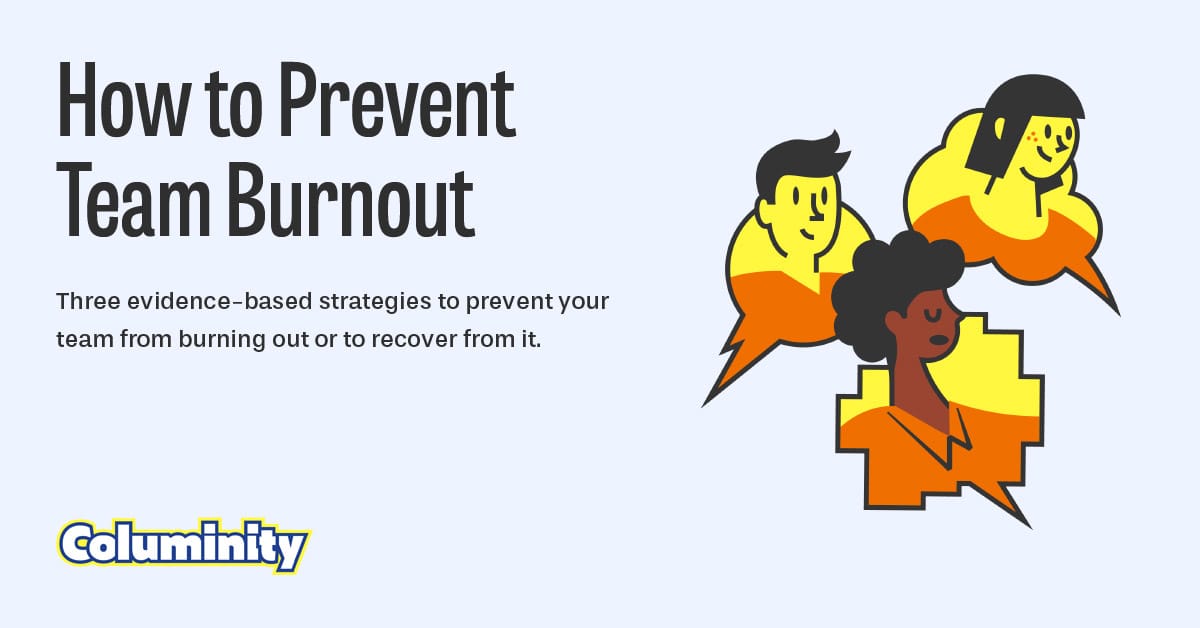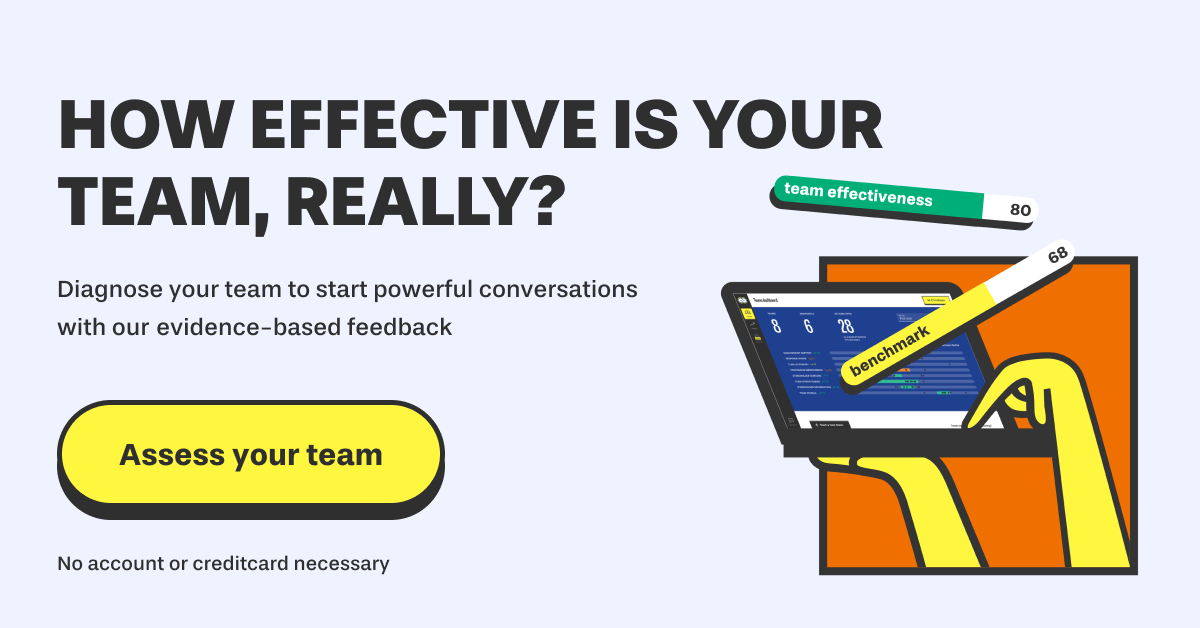How to Prevent Team Burnout

In a previous post, we discussed how high-performing teams can burn out. Team burnout is a recognized concept in the scientific literature on teams. While it shares similarities with individual burnout—people are exhausted and can no longer function correctly—it also contains a substantial subjective component of how stressful the work is and how burned out the team is.
In this post, we share three strategies to prevent team burnout from a scientific perspective. Unfortunately, no studies yet exist that investigate this specifically for high-performing teams. So, we rely on more general team research (Tulili, Capiluppi & Rastogi, 2023).
Strategy 1: Highlight the ability to self-manage
A lack of autonomy has been linked to burnout. Glass & McKnight (1996) reviewed 32 empirical studies, finding a modest correlation between low control and burnout risk. This connection makes sense—when individuals or teams feel they have no say over their workload or stressors, it can lead to a sense of entrapment, which may ultimately result in burnout.
The key factor here is the perception of autonomy. While high-performing teams often have the freedom to step back, take breaks, or adjust their workload, they may not feel like they can due to social expectations, self-imposed pressures, or cultural norms. Just as an individual can struggle with workaholism, entire teams can fall into a similar pattern.
High-performing teams can be coached to leverage their autonomy to reduce work pressure, both for the entire team and for individual members. Here are some powerful questions we like to ask:
- “What is one stressful task we can temporarily set aside to relieve pressure?”
- “If an outsider observed our work, what advice might they give us to manage stress better?”
- “What is a small, immediate change you can make to slow down—one that doesn’t require external approval or extra resources?”
The 15% Solutions technique from Liberating Structures is particularly effective in encouraging teams to focus on actions within their control. Similarly, the TRIZ exercise can be useful by asking, “What are all the extreme and counterproductive ways we could increase work pressure until burnout is inevitable?” After brainstorming, teams can flip the exercise to reflect on which of these tendencies they are already engaging in—often without realizing it.
Strategy 2: Highlight psychological safety and encourage people to listen
As discussed earlier, high-performing teams may feel pressure to keep pushing forward, even when it would be healthier to slow down. Individuals might hesitate to voice concerns, fearing they will be seen as weak or disruptive. Burnout in teams often stems from shared perceptions and group dynamics, making open conversations about stress and its management crucial.
This aligns with the concept of psychological safety, which Edmondson (1999) defines as “a shared belief held by members of a team that the team is safe for interpersonal risk-taking.” Research suggests that psychological safety helps mitigate stress and burnout by fostering open dialogue (Delizonna, 2017). However, simply having the opportunity to speak up is not enough—feeling truly heard is equally vital (Kerrissey, 2022). Interestingly, one study on healthcare teams suggests that psychological safety may actually decrease in response to burnout (Osei, Konadu & Osei-Kwame, 2022), creating a vicious cycle where people feel increasingly unable to express their concerns.
A proactive approach involves both normalizing conversations about stress before burnout occurs and coaching teams on effective listening. Educating teams about stress indicators and burnout effects, as outlined in this discussion, can also heighten awareness.
A practical way to foster these discussions is through Conversation Cafe, a Liberating Structure that teaches turn-taking and deep listening. Here are some suggested prompts:
- “Share a story of a time in your work when you experienced a lot of stress. What happened to you, your body, and how you interacted with others? What can we learn from this?”
- “How can we be a high-performing team on the one hand while also being able to slow down when we need to so we, or individual members, can catch our breath?”
Strategy 3: Create norms and work agreements to deal with stress
Unspoken or explicit norms within a team can contribute to burnout over time. For example, a team might routinely push through “crunch time” to meet a deadline, gradually normalizing excessive workloads. Likewise, a culture of dismissing or ignoring stress-related concerns can reinforce harmful expectations. Such norms may also be externally imposed by leadership or broader organizational culture. Over time, teams may attribute their success to these high-pressure habits, making them difficult to break.
The first step in addressing this is to bring existing norms into the open. A valuable tool for this is the 1–2–4-ALL method from Liberating Structures, with an invitation such as:
- “Think of a recent high-stress situation at work. What patterns emerge in how we responded as a team?”
A skilled coach can also observe and reflect on team behaviors, considering questions like:
- How does the team typically manage stress? Who takes charge? Who follows?
- What happens when stress signals arise? Are they acknowledged and addressed?
- Does the team naturally create space to pause, reflect, or engage in team-building?
Once these norms are made explicit, teams can work on modifying them to better handle stress. This might involve refining existing practices or introducing work agreements focusing on sustainable work habits. Here are some useful agreement prompts:
- “We support each other in maintaining a sustainable work pace by…”
- “When someone in the team experiences high stress, we…” (e.g., introduce a time-out and collectively decide on a path forward).
- “We commit to regularly checking in on stress levels and discussing how we are managing them as a team…”
By intentionally shaping these norms and agreements, teams can maintain high performance without sacrificing well-being.
Closing Words
Being part of a high-performing team is an enriching experience, but it also comes with pressures. Because these teams set high standards and operate with a strong sense of purpose, they often struggle to slow down when needed. In this post, we shared three strategies to prevent or reduce team burnout. Good luck!
You can measure team morale for your team(s) with Columinity, which is often the inverse of team burnout. Go to highperformingteams.columinity.com to try now. Our free plan is great for individual teams, but with a paid plan you can track this factor - and many others - across many teams in the same or different organizations.


